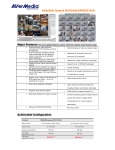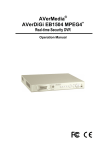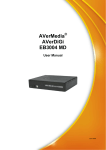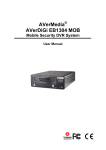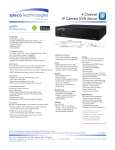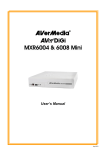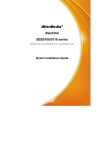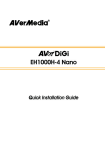Download Avermedia MXR6004 User guide
Transcript
AVerMedia® AVerDiGi MXR6004/6008 Mini Quick User Guide Contents Package Contents .............................................................................................. 1 Hardware Installation......................................................................................... 2 A. Install the hard disk............................................................................. 2 B. Device Connection ............................................................................. 3 Using the DVR For the First Time .................................................................... 4 A. Install the Surveillance Application ..................................................... 4 B. Connect a DVR Server for Monitoring ................................................ 4 C. Connect a IP Camera ......................................................................... 5 Familiarizing the Buttons in Preview Mode .................................................... 6 To Playback the Recorded Video ..................................................................... 8 Playback in Local Playback Mode .............................................................. 8 Playback in Download and Playback Mode .............................................. 12 Playback in RealTime Playback Mode ...................................................... 15 COPYRIGHT ©2009 by AVerMedia Information, Inc. All right reserved. Reproduction without permission is prohibited No part of this document may be reproduced or transmitted in any form, or by any means without the prior written permission of AVerMedia Information Inc. AVerMedia Information Inc. reserves the right to modify its models, including their characteristics, specifications, accessories and any other information stated herein without notice. The official printout of any information shall prevail should there be any discrepancy between the information contained herein and the information contained in that printout. i SPECIFICATIONS ARE SUBJECT TO CHANGE WITHOUT PRIOR NOTICE THE INFORMATION CONTAINED HEREIN IS TO BE CONSIDERED FOR REFERENCE ONLY WARNING TO REDUCE RISK OF FIRE OR ELECTRIC SHOCK. DO NOT EXPOSE THIS APPLIANCE TO RAIN OR MOISTURE WARRANTY VOID FOR ANY UNAUTHORIZED PRODUCT MODIFICATION For more information, please refer to the user manual in the software CD. If you still have inquiries, please log on to http://www.averdigi.com for troubleshooting Package Contents (2) (1) (4) (3) (6) (5) (1) AVerDiGi MXR6004/6008 Mini unit (4) HDD holder (including 8 screws) (2) Software CD (Manual is included) (5) Power adaptor (3) Quick User Guide (6) Power cord i If there is any damage, shortage or inappropriate item in the package contents, please contact with local dealer 1 Hardware Installation A. Install the hard disk Follow the steps to install the hard disk: 1. Loosen all screws 2. 3. Secure the brackets on the hard disk 4. Push the cover backward and lift Connect the end of the SATA cable and the power connector to the hard disk 5. Secure the hard disk inside the unit then 6. place unit cover 7. Push the cover forward and secure the cover You may now connect all the cables. When the power is connected, the Power LED light turns on 2 B. Device Connection The back panel of the DVR unit, user can connect the 4 sensor devices, 1 alarm device, audio input/output device and an external HDD storage device. Through the dual Gigabit LAN ports can balance the network bandwidth on the IP camera connection and preview live video. Follow the illustration below to make the connection: 3 Using the DVR For the First Time A. Install the Surveillance Application 1. Make sure the PC is connecting to your network. 2. Place the software CD into DVD-COM/CD-ROM drive on your PC. 3. Click Install MXR Client Software to install. And then, follow the on screen instruction to complete the installation. 4. After computer restarted, you may now run the MXR Client Software. To run the application, click i on your PC desktop or click Start > Programs > DVR > DVR Server > MXR. The PC must use independent graphic card in order to install the MXR Client Software. B. Connect a DVR Server for Monitoring 1. In order to connect with the DVR server, please change the IP address of your PC to the network IP segment of the DVR server. The default IP of the DVR server is 192.168.0.1 for LAN1 (lower LAN port in the back of the DVR) or 192.168.1.1 for LAN2 (upper LAN port in the back of the DVR). Therefore, please change the IP of your PC to 192.168.0.xxx or 192.168.1.xxx depends on which LAN port you connect the DVR. 2. Run the MXR Client Software on your PC. To run the application, click on your PC 3. Enter the ID and Password(default is superuser/111111) to login the MXR Client application. desktop or click Start > Programs > DVR > DVR Server > MXR. 4. Click (Setup) from MXR Client application interface. Enter the ID and Password (default is superuser/111111). And then, select Client Setup mode. The System Setting windows will show up. 5. Click Add, and then, click Search to find the DVR server that you have installed on your network. 6. Select the DVR server that you want to configure from the search result list and click OK. If search is not found any DVR server on your network, please make sure that IP of your PC is same as the IP segment with the IP of the DVR server. 7. After select the DVR server, click OK to exit the System Setting windows. And then, Click (Network) to connect with the selected DVR server. 8. After connection is made, please change the IP of the DVR server to your network IP segment. Click Setup > Network, and then click Setting of the Server IP in Main Configuration section. 9. Select the IP mode that your network is using -- Using the following IP address (Static IP), DHCP, or PPPOE. And then, enter the necessary parameters according to the IP mode that user has chosen. 10. After the IP of DVR server has changed, please remember to change back the IP of your PC. 4 11. Please re-connect to DVR server after IP has changed. Follow the above steps 4 to 5 to make a connection. C. Connect a IP Camera 1. Click (Setup) from surveillance application interface. Enter the ID and Password (default is superuser/111111). In Mode Select dialog, select Client Setup and click OK. 2. Select the Camera. The Camera setting windows will show up. 3. Select camera icon and enable the camera 4. Select IP Camera in Input section. Mark Display to show the video of the camera on the 5. Enter the Name and Description of the camera. screen. Mark Audio to enable the audio of the camera to be recorded. 6. Click IP Setting in IP Camera Information section. Enable Protocol, and then, select Protocol, Mode, Video Format, Channel, and IP Camera Site of the IP camera. 7. Instead enter IP address of the IP camera; user also can enter URL of the IP camera. 8. Enable Authentication, and then, enter ID and password if IP camera’s access authority is required. 9. Click OK to complete the setting. 5 Familiarizing the Buttons in Preview Mode Name (1) Exit Function Call up the Logout dialog box. In the logout dialog box, you may do the following: - Exit: To close the application - Reboot: To restart the DVR system. It is required to enter the password - Login: Using different ID to login to DVR system. - About: Display product information. - Minimize: To reduce the DVR to taskbar button. - Compact: To switch to compact mode. - Guest: To switch to the guest mode. In guest mode, the functions are limited to preview function only. For complete functions of DVR, please login as an administrator. - Cancel: To exit Logout dialog box. 6 Name Function (2) Split Screen Mode Select from 3 different split screen types to view all the camera, or one camera over the other or alongside on a single screen. It also allows you to switch and view different camera number. i – When you are in single screen mode, Right click and Drag a square on the area you want to enlarge. – When you are in full screen mode, partial enlarges does not support. (3) Record (4) EMap Start/stop server and client site video recording. - Server record: Start/stop recording at MXR DVR server. - Client record: Start/stop recording at remote client site. Display the map in each area, and the location of camera/ sensor/ relay and the warning. (5) Network Enable/disable remote system access. This feature allows you to access DVR server from a remote location via internet connection. The default is disabled. (6) Setup Configure the system settings. (7) PTZ Access PTZ control panel. (8) Preview Switch to Preview mode. This allows you to view live camera display. (9) Playback Switch to Playback mode. This allows you to view the recorded video file. (10) Status bar (11) Camera ID Display the recoding date, time and hard disk space of DVR unit. Show the number of cameras that are being viewed. When you are in single screen mode, click the camera ID number to switch and view other camera. (12) Snapshot Capture and save the screen shot in *.jpg format. (13) Event log Show the record of activities that take place in the system. (14) AutoScan Start/Stop video screen cycle switch. (15) Full screen View in full screen. To return, press the right button of the mouse or ESC on the keyboard or click the arrow icon. When you switch to full screen in multiple-screen mode, Left click to toggle to only display one of the video in the multiple-screen mode or all. (16) Alarm Alert and display warning info. (17) Virtual Keyboard If the keyboard is not available, you may use the Virtual Keyboard. (18) Audio Enable/disable audio. User can click the audio icon on the channel to switch the different channel’s volume play. When audio icon is green, it means the channel audio is playing now. 7 To Playback the Recorded Video To switch in Playback mode, click Playback button at the lower right corner of Preview mode user interface. In the Select Playback Mode dialog box, select Local Playback if user has enabled the client record. Select the RealTime Playback if your internet bandwidth is fast and big enough otherwise choose Download and Playback. Click OK to proceed and Cancel to void this operation. Playback in Local Playback Mode When selected the Local Playback mode, select the date and time to playback from the Video Playback Date/Time Selection. In the Video Playback Date/Time Selection, the number from 00 to 23 represent the time in 24-hour clock. The numbers from 01 to 16 represent the camera number. 8 The Download and Playback interface as following shown: Name Function (1) Split Screen Mode Select from 4 different split screen type to playback the recorded video file of all the camera, or one camera. i - If there are only 8 cameras, you won’t be able to switch to 13 and 16 split screen mode. - To zoom in an area on the screen, Right click and Drag a square on the area you want to enlarge. (2) Progress bar Show the progress of the file being played. You may move the bar to seek at any location of the track. (3) Hour Buttons Select and click to playback the recorded video file on the specific time frame. i The Hour buttons represent the time in 24-hour clock. The blue bar on top of the hour button indicates that there is a recorded video file on that period of time. While the red bar indicates that you are currently viewing the recorded video file. (4) Playback Control Begin: Move at the beginning of the recorded video file. Buttons Previous: Go back to the previous frame. Slower: Play the recorded video file at the speed of 1/2x, 1/4x, or 1/8x. Rewind: Wind back the recorded video file. Pause: Briefly stop playing the recorded video file. Play: Play the recorded video file. 9 Name Function (4) Playback Control Buttons Faster: Play the recorded video file at the speed of 2x, 4x, or 8x, 16x or 32x. Next: Go to the next frame. End: Go to the end of the recorded video file. (5) Archive i – Select the date on the calendar and the time from 00 to 23 to where to start playing the recorded video file. – Also, user can open the recorded file from certain location by click OPEN FILE button – Mark Day Light Saving, the playback calendar will show the available playback records during day light saving period. The numbers from 00 to 23 represent the time in 24-hour clock. The numbers from 01 to 16 represent the camera ID. The blue colored column indicates that there is a recorded video file on that period of time. While the red colored column indicates on where to start playing the recorded video file. (6) Preview Switch to Preview/Advanced mode. (7) Playback Switch to Playback mode. This allows you to view the recorded video file. (8) Status bar Display the recorded date, time and play speed. (9) Camera ID Show the number of cameras that are being viewed. When you are in single screen mode, click the camera ID number to switch and view other camera. (10) Export Export includes Snapshot, Print, Output Video Clip, and Backup function. Snapshot: Capture and save the screen shot either in *.jpg or *.bmp format. Print: Print the screen shot. Output Video Clip: Save the segmented file in *.mpg, *.avi, or *.dvr format. Backup: Save the playback file to USB device or DVD-ROM disk 10 Name Function (11) Segment Keep a portion of the recorded video. (12) Full screen View in Playback-compact mode. To return, press the right button of the mouse or ESC on the keyboard. When you switch to full screen in multiple-screen mode, Left click to toggle to only display one of the video in the multiple-screen mode or (13) Event log (14) Bookmark (15) Visual Search (16) Find Next all. Show the record of activities that take place in the system. To filter the records, select and click the option button to only display Event, System, Operation, Network or POS. Mark a reference point when previewing the recorded video file to which you may return for later reference. You may also set it to protect the file. Search from a specific camera by Date, Hour, Minute, 10 Seconds and Second. Search for the next event or changes in the motion detector frame. You can use this when you are using Intelligent Search or Event Search function. (17) Event Search Search from the recorded activities that take place in the system (i.e., (18) Intelligent Search Sensor, Motion, Video Loss, POS). Search the changes in the motion detector frame. (19) Audio Enable/disable audio play (20) De-interlace To enhance the video quality. Set the de-interlace mode to #1, if you are capturing motionless picture and #2, if it captures lots of movement. 11 Playback in Download and Playback Mode When selected the Download and Playback mode, select the date and time to playback from the Remote Playback Date/Time Selection. In the Remote Playback Date/Time Selection, the number from 00 to 23 represent the time in 24-hour clock. The numbers from 01 to 16 represent the camera number. Click OK and the Time Selection windows will show up. In Time Selection windows, the system divides the selected hour into 16 video thumbnails. Click on the video thumbnail you want to download and open. 12 The Download and Playback interface as following shown: Name Function (1) Exit To exit application (2) Progress bar Show the progress of the file being played. You may move the bar to seek at any location of the track. (3) Playback Control Begin: Move at the beginning of the recorded video file. Buttons Previous: Go back to the previous frame. Slower: Play the recorded video file at the speed of 1/2x, 1/4x, or 1/8x. Rewind: Wind back the recorded video file. Pause: Briefly stop playing the recorded video file. Play: Play the recorded video file. Faster: Play the recorded video file at the speed of 2x, 4x, or 8x, 16x or 32x. Next: Go to the next frame. End: Go to the end of the recorded video file. (4) Status bar Display the recorded date, time and play speed. (5) Language To switch the application tips’ display language 13 Name Function (6) Export Export includes Snapshot, Print, and Output Video Clip function. Snapshot: Capture and save the screen shot either in *.jpg or *.bmp format. Print: Print the screen shot. Output Video Clip: Save the segmented file in *.mpg, *.avi, or *.dvr format (7) Segment Keep a portion of the recorded video. (8) Full screen View in Playback-compact mode. To return, press the right button of the mouse or ESC on the keyboard. When you switch to full screen in multiple-screen mode, Left click to toggle to only display one of the video in the multiple-screen mode or all. (9) Event log Show the record of activities that take place in the system. To filter the records, select and click the option button to only display Event, System, Operation, Network or POS. (10) Visual Search Search from a specific camera by Date, Hour, Minute, 10 Seconds and Second. (11) Audio (12) De-interlace Enable/disable audio play To enhance the video quality. Set the de-interlace mode to #1, if you are capturing motionless picture and #2, if it captures lots of movement. 14 Playback in RealTime Playback Mode When selected the RealTime Playback mode, select the date and time to playback from the Video Playback Date/Time Selection. In the Video Playback Date/Time Selection, the number from 00 to 23 represent the time in 24-hour clock. The numbers from 01 to 16 represent the camera number. Mark Day Light Saving, the playback calendar will show the available video records during day light saving time period. Click OK and the RealTime Playback interface as following shown: 15 Name Function (1) Split Screen Mode Select from 3 different split screen type to playback the recorded video file of all the camera, or one camera. i - If there are only 8 cameras, you won’t be able to switch to 13 and 16 split screen mode. - To zoom in an area on the screen, Right click and Drag a square on the area you want to enlarge. (2) Progress bar Show the progress of the file being played. You may move the bar to seek at any location of the track. (3) Hour Buttons Select and click to playback the recorded video file on the specific time frame. i The Hour buttons represent the time in 24-hour clock. The blue bar on top of the hour button indicates that there is a recorded video file on that period of time. While the red bar indicates that you are currently viewing the recorded video file. (4) Playback Control Begin: Move at the beginning of the recorded video file. Buttons Previous: Go back to the previous frame. Slower: Play the recorded video file at the speed of 1/2x, 1/4x, or 1/8x. Rewind: Wind back the recorded video file. Pause: Briefly stop playing the recorded video file. Play: Play the recorded video file. Faster: Play the recorded video file at the speed of 2x, 4x, or 8x, 16x or 32x. Next: Go to the next frame. End: Go to the end of the recorded video file. (5) Archive i – Select the date on the calendar and the time from 00 to 23 to where to start playing the recorded video file. – Also, user can open the recorded file from certain location by click OPEN FILE button – Mark Day Light Saving, the playback calendar will show the available playback records during day light saving period. The numbers from 00 to 23 represent the time in 24-hour clock. The numbers from 01 to 16 represent the camera ID. The blue colored column indicates that there is a recorded video file on that period of time. While the red colored column indicates on where to start playing the recorded video file. (6) Preview Switch to Preview/Advanced mode. (7) Playback Switch to Playback mode. This allows you to view the recorded video file. (8) Status bar Display the recorded date, time and play speed. 16 Name Function (9) Camera ID Show the number of cameras that are being viewed. When you are in single screen mode, click the camera ID number to switch and view other camera. (10) Export Export includes Snapshot, Print, and Output Video Clip function. Snapshot: Capture and save the screen shot either in *.jpg or *.bmp format. Print: Print the screen shot. Output Video Clip: Save the segmented file in *.mpg, *.avi, or *.dvr format. (11) Segment (12) Full screen Keep a portion of the recorded video. View in Playback-compact mode. To return, press the right button of the mouse or ESC on the keyboard. When you switch to full screen in multiple-screen mode, Left click to toggle to only display one of the video in the multiple-screen mode or all. (13) Event log Show the record of activities that take place in the system. To filter the records, select and click the option button to only display Event, System, Operation, Network or POS. (14) Bookmark Mark a reference point when previewing the recorded video file to which you may return for later reference. You may also set it to protect the file. (15) Find Next Search for the next event or changes in the motion detector frame. You can use this when you are using Intelligent Search or Event Search function. (16) Event Search Search from the recorded activities that take place in the system (i.e., Sensor, Motion, Video Loss, POS). (17) Intelligent Search Search the changes in the motion detector frame. (18) Audio Enable/disable audio play (19) De-interlace To enhance the video quality. Set the de-interlace mode to #1, if you are capturing motionless picture and #2, if it captures lots of movement. 17





















